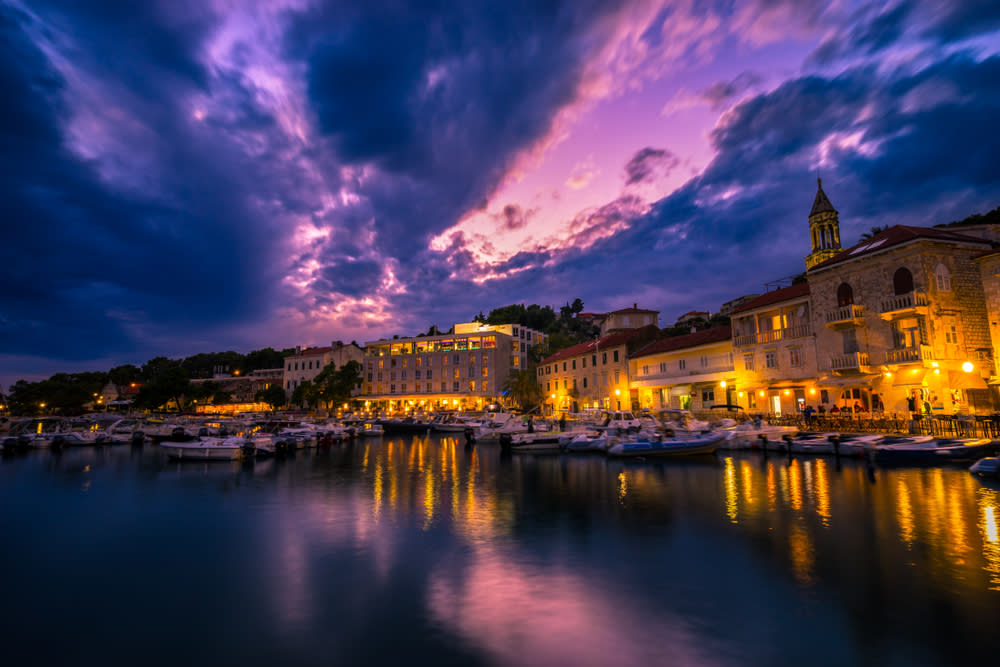More from Hvar
Main Menu
- 00:00
- 06:00
- 12:00
- 18:00
- 23:00
Hvar : Next 24-Hour Weather
Today - 26th April 2025
Sunrise 05:53
Sunset 19:47
Tomorrow - 27th April 2025
Sunrise 05:53
Sunset 19:47
Holiday Weather Now
Sorted by popularity:
Updated at 02:00 GMT
-
Temp feels like12°C53°F
-
Length of day13h 52m
-
Pressure29" (1009 hpa)
-
Visibility10 km (6miles)
-
Wind speed7 km/h
Sunrise 05:54
Sunset 19:46
-
Temp feels like:
12ºC (53 ºF)
-
Length of day:
13h 52m
-
Pressure:
29" (1009 hpa)
-
Visibility:
6 miles (10 km)
-
Wind speed:
7 km/h
Hvar is the largest city on the Croatian island of (you guessed it) Hvar which has been dubbed an âisland of sunâ due to the abundance of sunshine it receives. The city typically basks in 2715 hours of sunshine per year which is the most sun received anywhere on the Adriatic Coast (with an annual average of 7.7 hours of light every day and 3.8 hours of cloud). Hvarâs light and clement climate is responsible for the islandâs longstanding status as a popular tourist destination.
The island, like most of the Southern Adriatic region, experiences a Mediterranean climate which entails dry, hot summers and mild, though moist, winters (even in December, the average temperature is a tolerable 10.2°C). The highest recorded temperature for this resort is 37°C which was recorded in 1935. The average temperature remains above 10°C throughout most of the year; it only drops below that mark in January and February and even then, not by very much. The sea tends to be even warmer than the air except during the summer period (June to September) when the standard temperature is over 20°C.
The weather is even responsible for the construction of various buildings in Hvar. In 1579, as the townspeople were repairing the damage caused by a Turkish raid eight years earlier, lightning struck within the walls of the very fortress which had saved them from the Turks. In fact, the lightning happened to strike the fortressâs gunpowder magazine which exploded, ravaging the town even further. Many of Hvarâs public buildings were erected during the reconstruction period that was heralded (and indeed necessitated) by that storm.
Summer<?xml:namespace prefix = o ns = "urn:schemas-microsoft-com:office:office" />
Hvar experiences little rainfall during the summer months. July usually sees the least rain for the whole year with an average of 23mms. Due to the properties of Hvarâs Mediterranean climate, those rare summer rains are more likely to be the result of a thunderstorm. The average maximum temperature for June is 28°C while the minimum average is 20°C. July and August share the same average temperature range of 21°C to 29°C. At this time of year a westerly wind, which blows through the Pakleni channel, usually provides some relief from the heat.
Winter
The average high/low temperature ranges for December, January and February are 7-13°C, 5-12°C and 6-12°C respectively. Although snow is extremely uncommon in Hvar (only occurring roughly once every ten years), rain is rather prevalent, especially in December when the regular amount of precipitation is recorded at 105mm. Accurate forecasts can be viewed for up to seven days in advance of a visit.
Spring/Autumn
The average temperature for spring rises from 10.8°C in March to 18.2°C in May and the normal temperature for autumn slips from 21.4°C in September to 13.3°C in November. Rain is quite rare during spring; however autumn typically sees the most rain of the year. November is usually the wettest month to visit since, on average, 111mms of water pours forth during that period. Raincoats and hats may prove useful; however homemade gills are highly inadvisable as they offer no protection for oneâs hairstyle.

















